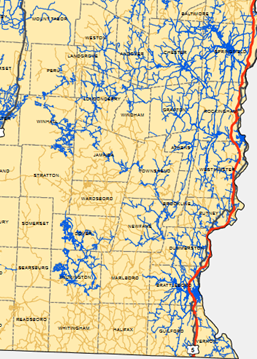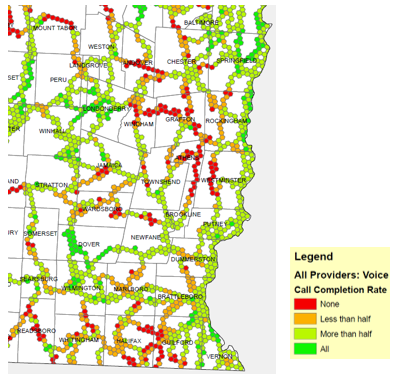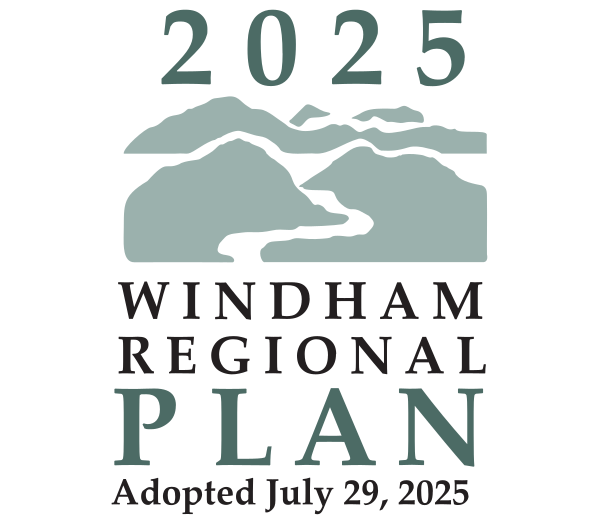Community Utilities, facilities, and services
Communications Infrastructure
Communications technology is rapidly advancing and adequate and reliable cellular and internet services are now essential infrastructure for all businesses, organizations, and residents in the region. Many rural towns and villages still lack sufficient internet and cellular infrastructure, which is a barrier when it comes to attracting new residents and businesses. At the same time, communications infrastructure can receive public resistance due to concerns of its negative impacts to the area’s natural and scenic resources. Development and maintenance of modern communications systems is vital to promote stronger connectivity within the region and provide quick and efficient connections with the rest of the country and world. This has become even more critical with the shift of some employers to offering remote work options.
The Public Utilities Commission established the following goals in the 2014 Vermont Telecommunications Plan relevant to communities in the Windham Region:
- Every address in Vermont should have available broadband Internet access with the minimum technical requirements of 4 megabits per second (Mbps) download and 1 Mbps upload. By year end 2020, a majority of addresses in Vermont should have access to the Internet at speeds of at least 100 Mbps symmetrical (download/upload), and every address should have access at speeds of at least 10 Mbps download.
- Every address in Vermont should have access to wired and wireless broadband Internet access service.
- Broadband service should be affordable to all members of every customer class.
- Universal adoption and use of broadband service at home and at work.
- Universal availability of mobile service along roadways and near universal availability statewide.
- Reliable, economical telephone service in all areas of the State, including rural areas. All residents, regardless of income or location, should have access to basic telephone service.
internet
Internet access in the Windham Region is provided by cable, DSL, fiber optic cable, cellular, wireless, and satellite. These different means for broadband access have a wide range of effectiveness and availability across the region. Broadband infrastructures is being expanded across the region and current availability data is regularly changing as improvements are made. Based on data collected by the Vermont Department of Public Service, as of November 2022, 72 percent of buildings in the Windham Region were served by internet at speeds of at least 100/20 Mbps, but 20 percent of buildings still lacked service of at least 25/3 Mbps as shown in Table 8-3 below.
TABLE 8-3: Internet service levels for windham region (November 2022)
| Service Level | Percent of Buildings in Windham Region |
|---|---|
| Served 100/100 | 33% |
| Served 100/20 or better | 72% |
| Served 25/3 or better | 80% |
| Served 4/1 or better | 97% |
| Lacking 4/1 | 3% |

or better in blue, November 2022
Source: Vermont Department of Public
Generally, the parts of the region served by 100/20 Mbps or better are located along major roadways in Connecticut and West River valley towns, in Wilmington and Dover along Routes 100 and 9 and adjacent roads, and in the Winhall, Londonderry, Weston areas. The map to the right depicts in blue roads and addresses served by 100/20 Mbps or better as of November 2022 according to data from the Vermont Department of Public Service. There are approximately 986 buildings, or 3 percent of total buildings, in the region that lack 4/1 Mbps service. These properties are primarily located in more isolated areas of the region because broadband providers tend to focus on areas with higher population concentrations. The communities of Dummerston, Halifax, Jamaica, Marlboro, Newfane, Readsboro, Searsburg, Somerset, Stratton, and Wardsboro have the highest rate (7 percent or greater) of buildings without 4/1 Mbps service.
The State of Vermont has invested significant funding in several initiatives over the last several years to improve broadband coverage. These have included the Broadband Innovation Grant program to help communities conduct studies and create business plans for broadband deployment, the Connectivity Initiative Grant for internet service providers to extend service to designated areas, and the Line Extension Customer Assistance Program that provided small-scale grants for telecommunication line extensions to properties just beyond the reach of existing infrastructure.
Much of the work to improve broadband access in rural and underserved areas in being completed by local Communication Union Districts (CUDs). For-profit companies, and in particular Fidium Fiber, are also expanding the availability of the fiber network. A CUD is a governing structure similar to a water or wastewater district that allows multiple municipalities to join together to address the need for improved broadband service. Broadband build-out expenses are covered by grants, service fees, and donations. CUDs cannot use municipal taxes for the infrastructure costs. There are currently two CUDs serving municipalities in the Windham Region: Deerfield Valley Fiber (DV Fiber) and Southern Vermont Communication Union District (SoVT CUD). Deerfield Valley Fiber represents 23 towns in the region. SoVT CUD represents two towns, Londonderry and Winhall, which are also members of DV Fiber. Rockingham, Grafton, Athens, and Somerset do not belong to a CUD at this time.
Cellular And Telephone Communications
Cellular phone service coverage varies widely in the region because some areas remain difficult and less practical to serve. Generally, the best cellular service coverage is found along the Interstate 91 corridor and major state highways, like Routes 9, 100, and 30. Based on driving tests completed by VTrans in the summer of 2022, areas in the region with the least cellular coverage include more remote areas in Guilford, Halifax, Whitingham, Readsboro, Wardsboro, Jamaica, Marlboro, Windham, Grafton, Athens, and Westminster. Coverage also varies based on the provider. The region is currently served by AT&T, FirstNet, T-Mobile, US Cellular, Verizon, and VTel Wireless.

Based on Drive Testing Conducted
July – September 2022 Using OOKLAN Wind Test software
Source: : Vermont Department of Public Service
Wireless telecommunication facilities in Vermont are permitted under the Section 248a process. Municipalities can also adopt zoning bylaws to regulate these facilities. However, applicants seeking approval through the Section 248a process are not required to adhere to local zoning bylaws. For projects requiring Section 248a permitting, the Public Utilities Commission is required to issue a Certificate of Public Good finding that the project will not unduly interfere with the orderly development of the region and with due consideration given to the recommendations of the municipality and the regional planning commission. The Section 248a process was set up to expedite the approval of telecommunication facilities and projects that are interconnected with other proposed or existing facilities are exempt from local zoning and Act 250. However, Act 250 still regulates towers over 50 feet in height from ground level or more than 20 feet in height above the structure it is attached to. In cases where an Act 250 permit is required for a tower, an applicant is also required to comply with any local zoning bylaws.
The demand is not only for the expansion of mobile voice services, but also mobile broadband internet access. To increase capacity and meet demands, service providers will likely need to increase the number of transmission sites in the region. While there is a need for improved cell phone service, the expansion of telecommunication facilities can potentially have environmental and aesthetic impacts. A concern for the WRC and for member towns is the impact that cellular towers and related facilities may have on rural and scenic landscapes and villages.
Vermont continues to have a high rate of households that still have a traditional phone landline. This is likely due in part to the lack of cellular service in rural locations, as well as household preferences. As cellular service expands, it will be important to retain landline services for those households that choose it, particularly for more vulnerable populations and those in remote areas.
